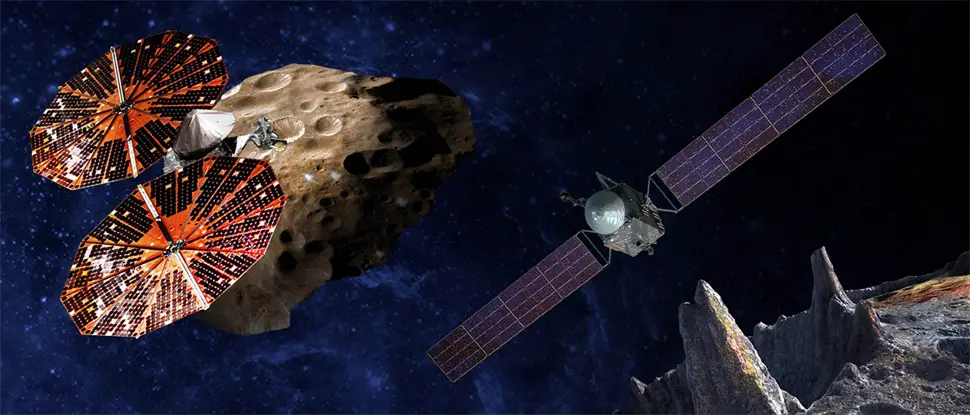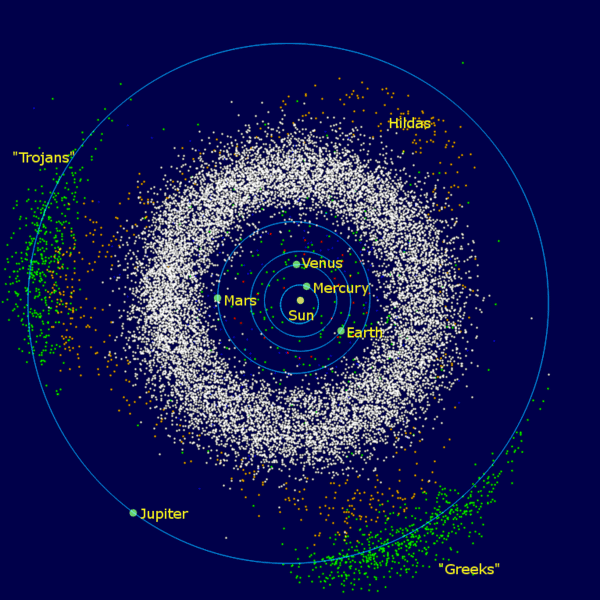
8th January 2017 NASA announces new space probes for the 2020s NASA has announced its choices for the next Discovery Program missions – Lucy, a probe that will visit several asteroids including the Trojans, and Psyche, to study the large metallic asteroid 16 Psyche.
NASA has selected two missions that have the potential to open new windows on one of the earliest eras in the history of our Solar System – a time less than 10 million years after the birth of our Sun. The missions, known as Lucy and Psyche, were chosen from 27 candidates that were narrowed down to five finalists in October 2015. They will now proceed to mission formulation, with the goal of launching in 2021 and 2023, respectively. "Lucy will visit a target-rich environment of Jupiter's mysterious Trojan asteroids, while Psyche will study a unique metal asteroid that's never been visited before," said Thomas Zurbuchen, associate administrator for NASA's Science Mission Directorate in Washington. "This is what Discovery Program missions are all about – boldly going to places we've never been to enable groundbreaking science." Lucy is scheduled to launch in 2021 and expected to arrive at its first destination, a main belt asteroid, in 2025. From 2027 to 2033, Lucy will explore six Jupiter Trojan asteroids. These asteroids are trapped by Jupiter's gravity in two swarms that share the planet's orbit, one leading and one trailing Jupiter in its 12-year circuit around the Sun. The Trojans are thought to be relics of a much earlier era in the history of the Solar System, and may have formed far beyond Jupiter's current orbit.
"This is a unique opportunity," said Harold Levison, lead investigator for the Lucy mission. "Because the Trojans are remnants of the primordial material that formed the outer planets, they hold vital clues to deciphering the history of the Solar System. Lucy, like the human fossil for which it is named, will revolutionise the understanding of our origins." Lucy will build on the success of NASA's New Horizons mission to Pluto and the Kuiper Belt – using more advanced versions of the scientific instruments that have enabled that probe's achievements. Several members of the Lucy mission team are also veterans of the New Horizons mission. Lucy will also build on the success of the OSIRIS-REx mission to asteroid Bennu, with the OTES instrument and several members of the OSIRIS-REx team. Meanwhile, the Psyche mission will explore one of the most intriguing targets in the main asteroid belt – a giant metal asteroid, known as 16 Psyche, about three times farther away from the Sun than is the Earth. This asteroid measures about 130 miles (210 km) in diameter and, unlike most other asteroids that are rocky or icy bodies, is thought to be composed primarily of metallic iron and nickel, similar to Earth's core. Astronomers wonder whether 16 Psyche could be an exposed core of an early planet that could have been as large as Mars, but which lost its rocky outer layers due to violent collisions billions of years ago. The mission will help scientists understand how planets and other bodies were separated into their layers – including cores, mantles and crusts – early in their histories. "This is an opportunity to explore a new type of world – not one of rock or ice, but of metal," said Psyche's principal investigator, Lindy Elkins-Tanton of Arizona State University in Tempe. "16 Psyche is the only known object of its kind in the Solar System, and this is the only way humans will ever visit a core. We learn about inner space by visiting outer space." Psyche, also a robotic mission, is targeted to launch in October of 2023, arriving at the asteroid in 2030, following an Earth gravity assist spacecraft manoeuvre in 2024 and a Mars flyby in 2025.
In addition to selecting Lucy and Psyche for mission formulation, the agency will extend funding for the Near Earth Object Camera (NEOCam) project for an additional year. The NEOCam space telescope is designed to survey regions of space closest to Earth's orbit, where potentially hazardous asteroids may be found. "These are true missions of discovery that integrate into NASA's larger strategy of investigating how the Solar System formed and evolved," said NASA's Planetary Science Director Jim Green. "We've explored terrestrial planets, gas giants, and a range of other bodies orbiting the Sun. Lucy will observe primitive remnants from farther out in the Solar System, while Psyche will directly observe the interior of a planetary body. These additional pieces of the puzzle will help us understand how the Sun and its family of planets formed, changed over time, and became places where life could develop and be sustained – and what the future may hold." Discovery-class missions like these are relatively low-cost, with development capped at $450 million. The Discovery Program portfolio includes 12 prior selections such as the MESSENGER mission to study Mercury, the Dawn mission to explore asteroids Vesta and Ceres, and the InSight Mars lander, scheduled to launch in May 2018. ---
Comments »
|








